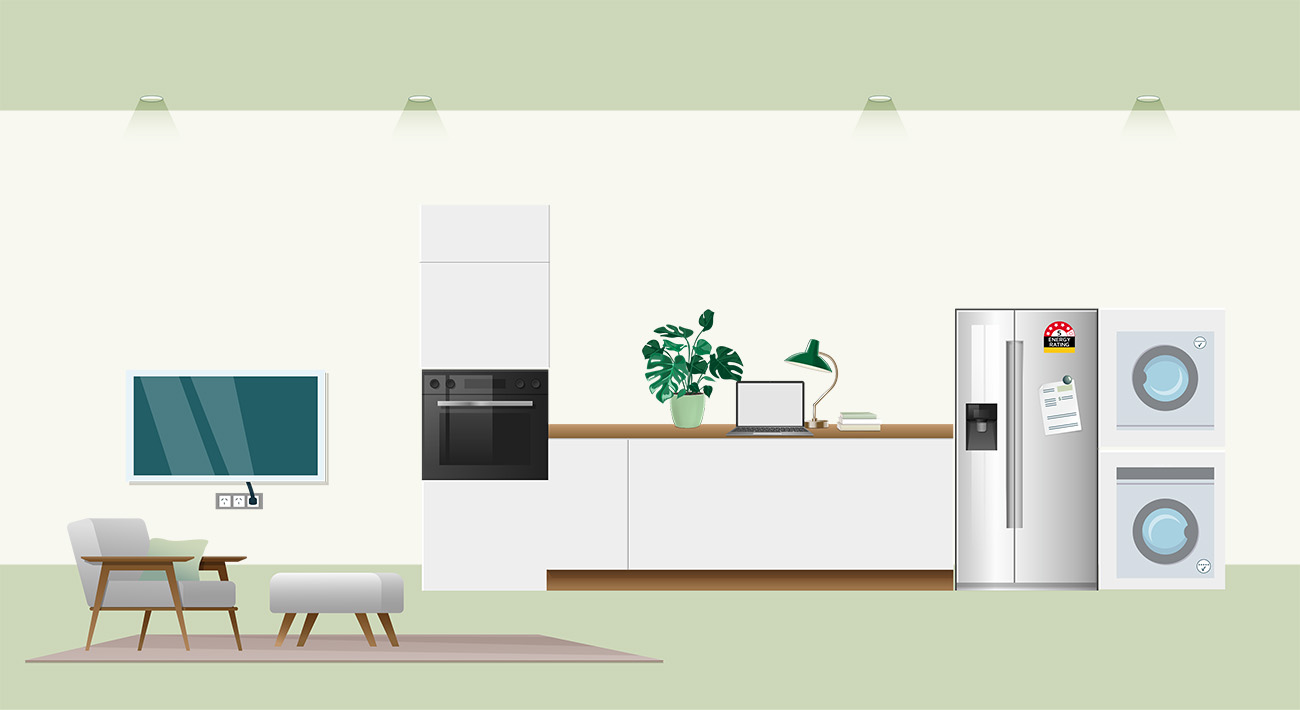Appliances and Lighting

 Lighting
Lighting Lighting - LEDs
Lighting can consume up to 10% of a home’s electricity consumption if inefficient lightbulbs are used, whereas LEDs are be up to 90% more energy efficient.
 Cooking
Cooking Cooking & dishwashing
If you are in the market for new appliances, choose an induction cooktop, a pyrolitic oven with a fan forced function, and a dishwasher with a 4-5 star energy rating.
Existing appliances can also be used more efficiently, click the button below to see our tips.
 Refrigerators & Freezers
Refrigerators & Freezers Refrigerators and freezers
Fridges are considerable energy users in a typical home, principally because they are never switched off. Replacing your old fridge with an energy efficient one can save up to 50% of the electricity consumption for that appliance.
Ensure you don't have more fridges than you need. If you have a rarely used second freezer or fridge, consider switching it off to save costs.
 Washing & Drying
Washing & Drying Washing and drying
Front loaders use about half the water and are cheaper to run than top loaders. Washing on a cold cycle can save 60-80% of energy.
Consider a Heat Pump Clothes Dryer. These are very energy efficient and can help you prevent moisture issues in the home, compared with line drying. If you have solar PV, wash and dry your clothes during the day.
 TVs
TVs TVs
When replacing your TV, choose an LCD or LED screen which use far less energy than older plasma or CRT technologies. There are also some ways of using your existing TV more efficiently.
 Computers
Computers Computers and accessories
Did you know computers account for about 5% of household electricity consumption? If you use multiple, larger monitors, this has the potential to increase your household electricity consumption.
Click the button below for some simple tips to reduce your computer's energy usage.
 Energy rating
Energy rating Energy rating
![]() The energy rating scheme enables consumers to compare the efficiency of appliances - more stars equates to more energy savings. Every extra star saves approximately 20% on running costs, with most products rated between 1 and 6 stars.
The energy rating scheme enables consumers to compare the efficiency of appliances - more stars equates to more energy savings. Every extra star saves approximately 20% on running costs, with most products rated between 1 and 6 stars.
 Wall plug
Wall plug Switch appliances off at the wall
Even when ‘switched off’, many appliances continue to use energy in standby mode, which can contribute 3-5% of a household’s energy use.
Other than fridges, freezers or any critical medical equipment, it is important to switch appliances off at the wall or use timers as appropriate.
Australian households generate around 20 per cent of Australia’s total carbon emissions, an average of between 7-14 tonnes per household each year. Appliances contribute up to 30% and lighting typically accounts for around 10% of an Australian home’s energy consumption.
Even when ‘switched off’, many appliances continue to use energy in standby mode, which can contribute 3-5% of a household’s energy use. Other than fridges, freezers or any critical medical equipment, it is important to switch appliances off at the wall or use timers as appropriate.
Energy ratings for appliances
The energy rating scheme is a joint initiative of Federal and State Governments, enabling consumers to compare the efficiency of one model relative to other models of the same size - more stars equates to more energy savings. Every extra star saves approximately 20% on running costs, with most products rated between 1 and 6 stars.
Energy rating stickers also typically display annual energy consumption in kWh. The lower the number, the less a model costs to run – and the less you pay on your electricity bill. When buying a new appliance, look for the highest star rating and lowest energy consumption. For more information visit www.energyrating.gov.au.
You can work out how much your old appliances use by multiplying the wattage of the appliance (often found on the base) by the number of hours used per day. Divide this by 1000 to obtain your daily kWh and then multiply by the rate per kWh on your energy bill to find out how much the appliance is costing you each day.
Go Electric!
When buying new appliances, choose electric over gas. There are many good reasons for this, in particular the inclination towards highly efficient heat pump technologies, as well as capacity to generate electricity onsite (solar PV) which reduces exposure to the volatility of energy markets. For more information see Greenhouse gas footprint: What we do and don’t know about gas - Renew
Cooking and dishwashing
Cooktops
Electric induction cooktops are the most energy efficient, closely followed by electric resistive cooktops. Induction cooktops allow 90% of heat to reach food, as opposed to 65-70% for electric resistive cooktops. Gas cooktops are even less efficient.
Cooking creates steam which can create mould when left to build up. Ensure you have your extraction fan on and a window open when you are cooking. See the Ventilation & Moisture Management section for more details.
Ovens
In Australia there are no star ratings for ovens. Pyrolytic ovens are generally the most energy efficient ovens as they have triple or even quadruple glass and better seals, and therefore better insulation.
Also make sure your oven has a fan-forced option. Fan-forced ovens circulate hot air evenly, which keeps the temperature constant and cooks food quicker and at lower temperatures than conventional ovens.
If you are not in the market for a new oven, there are ways of using your existing oven more efficiently:
- Keep the oven door closed. Opening the oven door allows heat to escape, requiring more energy to make up for that lost heat.
- Check the oven door seal and hinges. Replace them if they are damaged, cracked or too loose. Heat lost from the oven through gaps and cracks is wasted energy.
- Cook several dishes at once. This will make sure all the space and heat is being used.
- Turn the oven off before removing food. This will let the residual heat complete the cooking process.
- Use the fan forced option. Fan-forced allows you to cook at a lower temperature.
- Use an electric fry pan, pressure cooker or microwave oven where possible. Smaller appliances use a lot less energy than an electric oven and often cook food quicker.
- Consider using a slow cooker. Some slow cookers can be quite efficient, but beware as some models are poorly insulated and use a lot of electricity.
Source - Sustainability Victoria | Reduce cooking appliance costs at home
Dishwashers
Dishwashers can use less water than hand washing and have become increasingly energy efficient over the years. There are things you can do to ensure you are using the least amount of energy:
- Run your dishwasher on an eco cycle. This may take longer but will be more efficient than a regular cycle.
- Make sure your dishwasher is full before you switch it on.
- When replacing your dishwasher select a dishwasher with a 4-5 star energy rating.
- Look for both hot and cold water connections: Machines with both connections will import hot water from your water heater (which may require less energy) rather than allowing your dishwasher to heat its own water possibly less efficiently.
- Remember to clean your filter regularly - this will ensure the dishwasher runs as efficiently as possible.
- For smaller loads, it is usually more energy efficient to hand wash.
Lighting - LEDs
When looking at lighting in your home, it is advisable to replace all light globes with LEDs where possible. Lighting can consume up to 10% of a home’s electricity consumption if inefficient lightbulbs are used, whereas LEDs are up to 90% more energy efficient.
Using downlights rather than pendant or fluorescent fittings will mean you need to install more lights to light the same area, resulting in higher energy use and running costs. Downlights penetrate your ceiling plaster, which can result in fresh air leaking out of your living space and roofspace air leaking in.
Batten or pendant lights with LED globes are the most energy efficient option. You can also make sure you turn lights off when you leave the room or install motion sensing lights.
Washing and drying clothes
If you have solar PV available, it is a good idea to run your washing machine or clothes dryer during the day. Washing on a cold cycle can save 60-80% of energy.
When choosing a new washing machine, choose a front loader. Front loaders use about half the water and are cheaper to run than top loaders.
Clothes dryers used to be frowned upon as a huge waste of electricity. Nowadays, heat pump clothes dryers with up to 10 star energy ratings are readily available. They are easy to install as they generally do not need to be plumbed in, and are highly efficient to run.
If your house is fairly airtight, drying clothes on a rack inside may not be a great idea as this can create condensation, leading to moisture build up and mould problems. Drying clothes outside or using a heat pump clothes dryer are better options. See the Ventilation & Moisture Management section for more information.
Refrigerators and freezers
Fridges are considerable energy users in a typical home, principally because they are never switched off. On average, they make up 13% of your energy bill.
According to Australian Government website Your Home, replacing your old fridge with an energy efficient one can save up to 50% of the electricity consumption for that appliance.
Products with additional features, such as ice-makers, may use more energy than products without those features. A two-door fridge with the top and bottom configuration is more energy efficient than a side-by-side model.
Also ensure you don’t have a larger fridge than you need - if your fridge has lots of free space, it may be time to downgrade. If you run 2 fridges, but could get away with one, consider removing or switching one off to save costs.
Clean your fridge seals regularly - you can check the door seal by placing a piece of paper in the seal and closing the door. The paper will hold firmly if the seal is working.
It is important to dust the coils on the back of your fridge once a year to maintain its efficiency.
The temperature of your fridge and freezer has a significant impact on the amount of energy it uses - set the temperature of your fridge to between 3- 5 degrees and the freezer to -18 degrees.
It is also important to choose the right spot for your fridge - don’t place fridges next to ovens, windows or other heat sources where they will need to work harder to stay cool.
Computers and accessories
Did you know computers account for about 5% of household electricity consumption? If you use multiple, larger monitors, this has the potential to increase your household electricity consumption.
Below are some simple tips for reducing your energy usage for your computer:
- Don’t use screen savers.
- Reduce your screen brightness.
- Choose a computer monitor with a higher star rating - refer to energyrating.gov.au and aim for the higher end of the star ratings.
- Use an energy saving powerboard for your computer, printer, modem etc.
- Switch your modem / NBN off at night and when you leave the house.
TVs
The type of technology used in your television will impact how much power it uses. When replacing your TV, choose an LCD or LED screen which use far less energy than older plasma or CRT technologies. Refer to www.energyrating.gov.au and aim for the higher end of the star ratings.
You can also reduce the brightness of your screen, switch to eco mode, turn your TV off at the wall when the TV is not in use and consider reducing the number of TVs you have in the house.
Rebates
The Victorian government has a range of rebates available for upgrading certain appliances to more energy efficient models. See Victorian Energy Upgrades for details.
